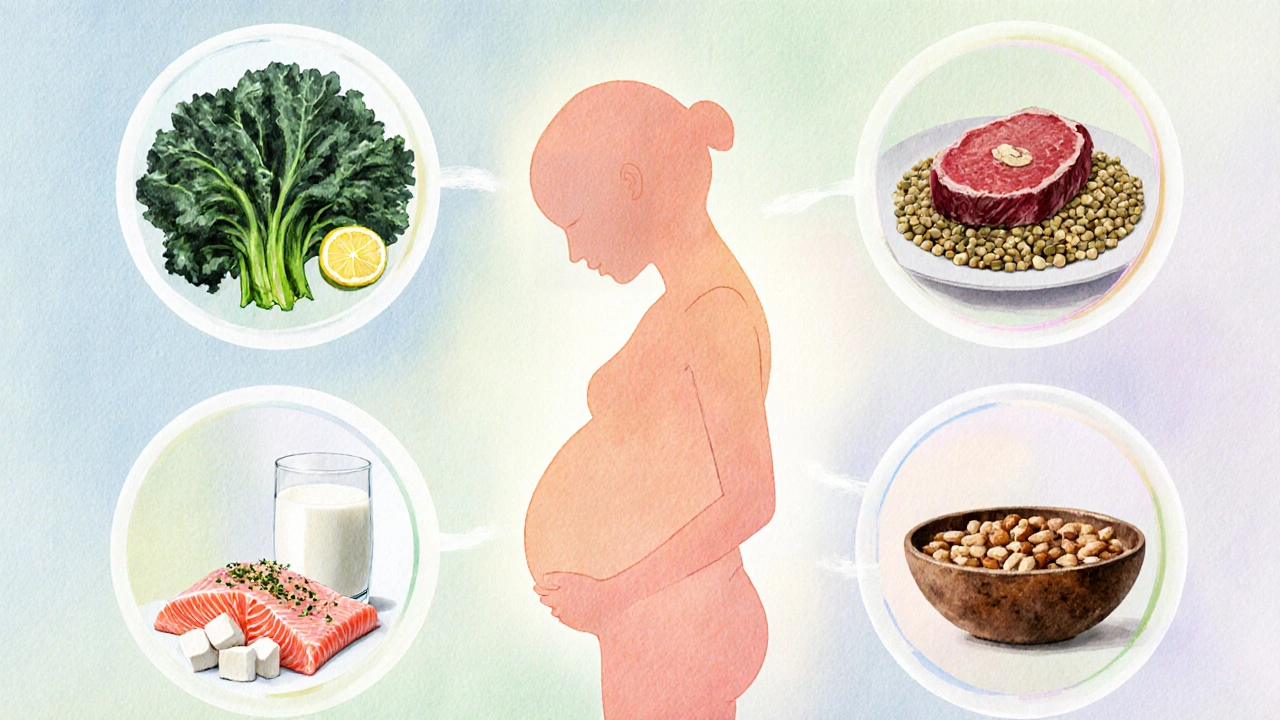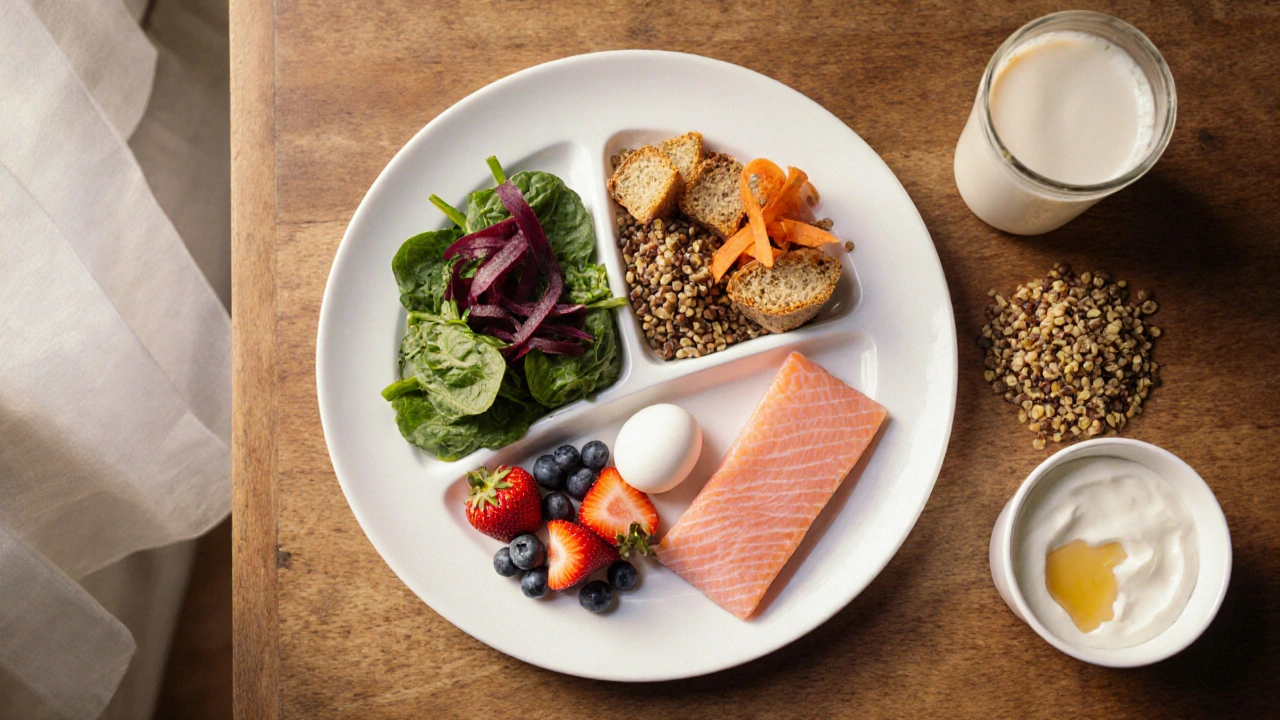Deciding what to put on your plate while you’re expecting can feel overwhelming. You want to support your growing baby, keep your energy up, and avoid cravings that leave you feeling guilty. This guide cuts through the noise and shows you exactly which foods to focus on, how much to eat, and simple tricks to stay nourished throughout every trimester.
Key Takeaways
- Prioritize folate, iron, calcium, omega‑3s, and quality protein every day.
- Aim for 2‑3 servings of fruit, 3‑5 servings of vegetables, 6‑8 servings of whole grains, and 2‑3 dairy servings each day.
- Include a prenatal vitamin that fills any nutritional gaps.
- Stay hydrated and manage nausea with small, frequent meals.
- Avoid raw fish, unpasteurized cheese, and excessive caffeine.
Why nutrition matters for your baby
What you eat directly fuels the placenta, which delivers oxygen and nutrients to the fetus. A well‑balanced diet reduces the risk of low birth weight, preterm birth, and developmental issues. It also helps you avoid common pregnancy complications like gestational diabetes and anemia.
Core nutrients and their food sources
Pregnancy Nutrition is the collection of foods and nutrients that support fetal growth and maternal health during pregnancy. Below are the five nutrients that research shows have the biggest impact.
Folate a B‑vitamin that helps form the neural tube and prevents spina bifida is abundant in leafy greens, lentils, and fortified cereals. Aim for 600µg daily.
Iron supports the extra blood volume and prevents maternal anemia comes from lean red meat, beans, and spinach. Pair with vitaminC‑rich foods to boost absorption.
Calcium builds the baby’s bones and teeth while maintaining your own bone density is found in dairy, fortified plant milks, and tofu. Target 1,000mg per day.
Omega‑3 fatty acids especially DHA, are crucial for brain and eye development are supplied by salmon, sardines, walnuts, and algae‑based supplements.
Protein provides the building blocks for tissue growth and hormone production should make up about 20‑25% of daily calories, sourced from poultry, eggs, beans, and low‑fat dairy.
Most women also benefit from a Prenatal vitamin that supplies folic acid, iron, iodine, and DHA in safe, absorbable forms to cover any shortfalls.

Daily serving guide
Think of your plate as a colorful palette. The table below translates the recommended servings into practical portions.
| Food Group | Servings per Day | Example Portion |
|---|---|---|
| Fruits | 2-3 | 1 medium apple or 1 cup berries |
| Vegetables | 3-5 | 1 cup raw leafy greens or ½ cup cooked |
| Whole Grains | 6-8 | 1 slice whole‑grain bread or ½ cup cooked quinoa |
| Protein | 2-3 | 3oz lean meat, ½ cup beans, or 2 eggs |
| Dairy (or fortified alternatives) | 2-3 | 1 cup milk/yogurt or 1.5oz cheese |
| Healthy Fats | 2-3 tbsp | 1 tbsp olive oil or a handful of nuts |
Tips to handle cravings and common issues
Morning sickness often pushes you toward bland carbs. Keep a stash of ginger tea, crackers, and a banana to settle your stomach while still getting nutrients.
If you’re battling iron‑deficiency fatigue, add a squeeze of lemon to your spinach salad-vitaminC triples iron absorption.
Craving salty snacks? Choose roasted chickpeas or low‑sodium cheese slices instead of processed chips.
Sample meal plan (day in the life)
- Breakfast: Greek yogurt topped with sliced kiwi, a sprinkle of chia seeds, and a drizzle of honey.
- Mid‑morning snack: Whole‑grain toast with avocado and a poached egg.
- Lunch: Quinoa salad with roasted salmon, mixed greens, orange segments, and a citrus vinaigrette.
- Afternoon snack: Apple slices paired with almond butter.
- Dinner: Stir‑fry tofu, broccoli, bell peppers, and carrots over brown rice, seasoned with ginger and low‑salt soy sauce.
- Evening snack (if needed): Warm milk with a dash of cinnamon.
This plan hits all the core nutrients, provides steady energy, and keeps you hydrated.

Safety and what to avoid
Some foods carry higher risks for pregnant women. Limit or eliminate:
- Raw or undercooked fish (risk of mercury) - choose cooked salmon or sardines.
- Unpasteurized cheese and dairy - risk of Listeria.
- High‑caffeine drinks (>200mg per day) - may affect fetal heart rate.
- Alcohol - no safe level established.
- Excessive sugary snacks - can spike blood glucose and contribute to gestational diabetes.
When in doubt, ask your health provider whether a specific food is safe.
Putting it all together
Think of pregnancy nutrition as a daily checklist: fill your plate with color, hit the serving targets, and supplement wisely. Keep a food diary for a week, note how you feel, and adjust portions as your appetite changes. Consistency beats perfection-steady, nutrient‑dense meals will give your baby the best start.
Frequently Asked Questions
How many calories should I eat during pregnancy?
In the first trimester, most women need about the same calories as before pregnancy. In the second trimester, add roughly 340kcal per day, and in the third trimester, about 450kcal, depending on activity level and pre‑pregnancy weight.
Can I get enough folate from food alone?
It’s possible, but many doctors recommend a folic‑acid supplement (400µg) in addition to folate‑rich foods to guarantee the recommended 600µg daily intake, especially early in pregnancy.
Is it safe to eat sushi while pregnant?
Avoid raw fish due to mercury and parasite risks. Choose cooked sushi rolls (e.g., eel or tempura) or opt for vegetarian rolls made with avocado and cucumber.
What should I do if I’m constantly nauseous?
Eat small, frequent meals; keep crackers or dry toast by the bedside; sip ginger tea; and stay hydrated. If nausea persists beyond the first trimester, consult your provider for safe anti‑nausea options.
Do I need to stop taking my regular vitamins?
Switch to a prenatal vitamin that contains higher levels of folic acid, iron, iodine, and DHA. Your doctor can advise on any additional supplements you might need.


Meg Mackenzie
October 12, 2025 AT 06:23It feels like big pharma and corporate seed companies are pulling the strings behind every "essential nutrient" listed here. They want us to buy pricey supplements while the real solution is simple, whole foods that they've been trying to push out of the market for years. The article glosses over the fact that many of these recommendations are funded by the same companies that profit from pregnant women’s anxieties. I can’t help but wonder who’s really benefitting from this “guide”. If you look closely, the language is carefully crafted to keep us dependent on their products. Stay skeptical and do your own digging.
Shivaraj Karigoudar
October 17, 2025 AT 18:23Namaste dear readers, let us embark on an odyssey of gastronomic inclusivity that honors the polycultural tapestry of our motherlands while navigating the biochemical imperatives of gestation.
First, understand that folate isn’t just a solitary molecule, it is a nexus of methylation pathways that have been described in epigenetic literature as “the silent architects of phenotypic destiny”.
In many South Asian households, the traditional staple of lentil dal fortified with ghee provides a rich source of both folate and iron, a synergy that modern food science often overlooks.
Yet, the western-centric narrative tends to elevate fortified cereals, an approach that inadvertently marginalizes regional culinary wisdom.
When you stir turmeric into your sautéed spinach, you aren’t merely adding flavor; curcumin may modulate inflammatory cascades, which could be beneficial during the immunological shifts of pregnancy.
It is critical to recognize that the bioavailability of iron from plant sources is dramatically enhanced by concomitant ascorbic acid, thus a squeeze of lemon over a bean salad isn’t just garnish, it’s a strategic nutritional maneuver.
The omega‑3 DHA commonly sourced from salmon can alternatively be obtained from algae‑based supplements, a point of relevance for vegetarian households seeking to avoid overfishing‑related ecological footprints.
From a metabolic standpoint, the recommended 6‑8 servings of whole grains should be interpreted as a call for diversity: millets, quinoa, and sorghum each bring distinct micronutrient profiles that complement the macro‑nutrient matrix.
Do not forget the probiotic dimension; fermented foods such as idli, dosa batter, or kefir introduce beneficial microbiota that may subtly influence maternal gut health and, by extension, fetal immune programming.
Moreover, calcium absorption is contingent upon vitamin D status, which in turn is modulated by geographic latitude and skin pigmentation – a nuance often absent from one‑size‑fits‑all charts.
In practical terms, a daily cup of fortified soy milk can serve dual purposes: calcium and vitamin D, while also providing a complete protein matrix for lactovegetarians.
Equally, the glycemic load of carbohydrate sources matters; opting for low‑glycemic index grains can temper gestational diabetes risk, an issue that disproportionately impacts South Asian populations.
While the article mentions prenatal vitamins, it neglects to discuss the importance of iodine, a micronutrient critical for neurodevelopment, particularly in regions with iodine‑deficient soils.
In conclusion, think of your plate as a diplomatic summit of nutrients, each representing a cultural cohort, and aim for equitable representation rather than a token nod to Western guidelines.
May your pregnancy journey be nourished by both scientific rigor and the timeless wisdom of ancestral kitchens.
Matt Miller
October 23, 2025 AT 06:23Great summary, thanks!
Fabio Max
October 28, 2025 AT 18:23Loving the clear tables – they make meal planning way less intimidating. Keep the positive vibe, it really helps new moms feel confident.
Darrell Wardsteele
November 3, 2025 AT 06:23Just a heads‑up, “6‑8 servings of whole grains” can be misleading; the USDA defines a serving as one slice of bread, which isn’t always whole grain.
Madeline Leech
November 8, 2025 AT 18:23This guide is solid but remember, moderation is key. Don’t let the “everything in moderation” mantra turn into an excuse to overindulge.
Barry White Jr
November 14, 2025 AT 06:23Sounds good
Andrea Rivarola
November 19, 2025 AT 18:23Reading through this article reminded me of the first time I was pregnant and utterly bewildered by the avalanche of nutrition advice that seemed to change with every trimester.
The sheer volume of information can be paralyzing, especially when you’re also juggling work, appointments, and the emotional roller‑coaster that pregnancy inevitably brings.
What struck me most was the emphasis on diversity of food groups – a reminder that no single food can be a magic bullet for fetal development.
For instance, the focus on folate reminded me of a study I read where women who ate a diet rich in leafy greens and legumes had lower rates of neural tube defects, even without supplementation.
Equally, the iron recommendations resonated because I personally experienced fatigue that was only alleviated after I started pairing beans with vitamin‑C rich fruits, confirming the iron‑absorption trick mentioned here.
The calcium section prompted me to swap my regular cow’s milk for fortified almond milk, which not only met my calcium needs but also reduced my lactose discomfort.
I also appreciated the practical tip about ginger tea for nausea; my sister swore by it during her second trimester when morning sickness hit peak levels.
The table with serving sizes is a gem – visualizing portions makes it easier to track intake without obsessively counting calories.
Furthermore, the advice to stay hydrated aligns with the physiological increase in blood volume that occurs during pregnancy, a factor often overlooked in generic diet guides.
One thing I would add is a note on the importance of iodine, especially for those living in regions with low‑iodine soils, as it’s crucial for thyroid function and neurodevelopment.
Also, while the article warns against raw fish, many cultures rely on sushi‑style dishes that are prepared with cooked fish, which can be a safe source of omega‑3s if handled properly.
It’s also worthwhile to consider cultural dietary preferences – for example, for vegetarians, incorporating tofu, tempeh, and fortified cereals can ensure adequate protein and B‑vitamin intake.
The suggestion to keep a food diary is something I’ve personally found invaluable; it helps spot patterns, like cravings that may signal a nutrient deficiency.
Overall, this guide strikes a balance between scientific evidence and actionable tips, making it a reliable companion for expectant mothers navigating the nutritional maze.
Remember, every pregnancy is unique, so listening to your body and consulting with a healthcare provider remains paramount.
Tristan Francis
November 25, 2025 AT 06:23Sounds useful, but watch out for hidden sugars in “healthy” snacks.
Keelan Walker
November 30, 2025 AT 18:23Wow this guide really breaks it down 😍 love the color coded plate ideas 🍽️ it's like having a nutritionist in your pocket 🙌 keep it up
Heather Wilkinson
December 6, 2025 AT 06:23💖 Such a friendly and helpful rundown! It’s great to see practical tips that actually feel doable. 🙏
Henry Kim
December 11, 2025 AT 18:23Thanks for highlighting the importance of pairing iron‑rich foods with vitamin C; that tip can make a big difference for those dealing with fatigue. Also, the reminder to stay hydrated is essential since dehydration can worsen morning sickness. Keep sharing these evidence‑based nuggets!